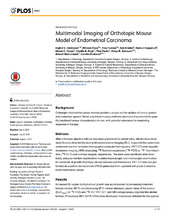| dc.contributor.author | Haldorsen, Ingfrid S. | en_US |
| dc.contributor.author | Popa, Mihaela Lucia | en_US |
| dc.contributor.author | Fonnes, Tina | en_US |
| dc.contributor.author | Brekke, Njål | en_US |
| dc.contributor.author | Kopperud, Reidun Kristin | en_US |
| dc.contributor.author | Visser, Nicole C. | en_US |
| dc.contributor.author | Rygh, Cecilie Brekke | en_US |
| dc.contributor.author | Pavlin, Tina | en_US |
| dc.contributor.author | Salvesen, Helga Birgitte | en_US |
| dc.contributor.author | McCormack, Emmet | en_US |
| dc.contributor.author | Krakstad, Camilla | en_US |
| dc.date.accessioned | 2019-01-09T15:47:10Z | |
| dc.date.available | 2019-01-09T15:47:10Z | |
| dc.date.issued | 2015-08-07 | |
| dc.identifier.issn | 1932-6203 | |
| dc.identifier.uri | https://hdl.handle.net/1956/18868 | |
| dc.description.abstract | Background: Orthotopic endometrial cancer models provide a unique tool for studies of tumour growth and metastatic spread. Novel preclinical imaging methods also have the potential to quantify functional tumour characteristics in vivo, with potential relevance for monitoring response to therapy. Methods: After orthotopic injection with luc-expressing endometrial cancer cells, eleven mice developed disease detected by weekly bioluminescence imaging (BLI). In parallel the same mice underwent positron emission tomography–computed tomography (PET-CT) and magnetic resonance imaging (MRI) employing 18F-fluorodeoxyglocose (18F-FDG) or 18F- fluorothymidine (18F-FLT) and contrast reagent, respectively. The mice were sacrificed when moribund, and post-mortem examination included macroscopic and microscopic examination for validation of growth of primary uterine tumours and metastases. PET-CT was also performed on a patient derived model (PDX) generated from a patient with grade 3 endometrioid endometrial cancer. Results: Increased BLI signal during tumour growth was accompanied by increasing metabolic tumour volume (MTV) and increasing MTV x mean standard uptake value of the tumour (SUVmean) in 18F-FDG and 18F-FLT PET-CT, and MRI conspicuously depicted the uterine tumour. At necropsy 82% (9/11) of the mice developed metastases detected by the applied imaging methods. 18F-FDG PET proved to be a good imaging method for detection of patient derived tumour tissue. Conclusions: We demonstrate that all imaging modalities enable monitoring of tumour growth and metastatic spread in an orthotopic mouse model of endometrial carcinoma. Both PET tracers, 18F-FDG and 18F-FLT, appear to be equally feasible for detecting tumour development and represent, together with MRI, promising imaging tools for monitoring of patient-derived xenograft (PDX) cancer models. | en_US |
| dc.language.iso | eng | eng |
| dc.publisher | Public Library of Science | eng |
| dc.relation.ispartof | <a href=" http://hdl.handle.net/1956/18869" target="blank"> Preclinical models and molecular biomarkers. Tools to improve treatment in endometrial carcinoma</a> | |
| dc.rights | Attribution CC BY | eng |
| dc.rights.uri | http://creativecommons.org/licenses/by/4.0/ | eng |
| dc.title | Multimodal Imaging of Orthotopic Mouse Model of Endometrial Carcinoma | en_US |
| dc.type | Peer reviewed | |
| dc.type | Journal article | |
| dc.description.version | publishedVersion | en_US |
| dc.rights.holder | Copyright 2015 Haldorsen et al. | |
| dc.source.articlenumber | e0135220 | |
| dc.identifier.doi | https://doi.org/10.1371/journal.pone.0135220 | |
| dc.identifier.cristin | 1284065 | |
| dc.source.journal | PLoS ONE | |
| dc.source.40 | 10 | |
| dc.source.14 | 8 | |

